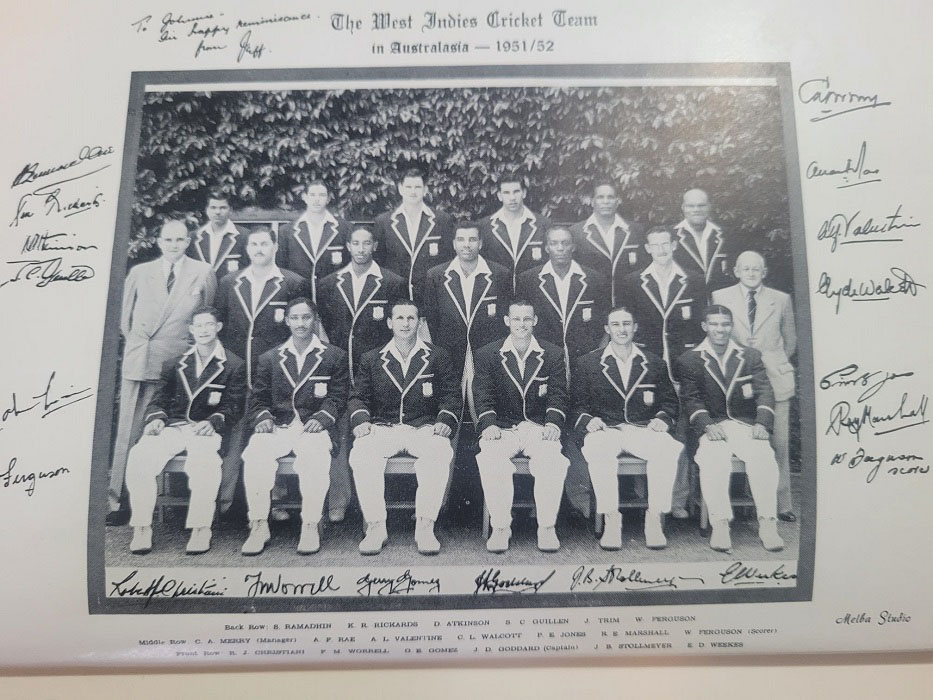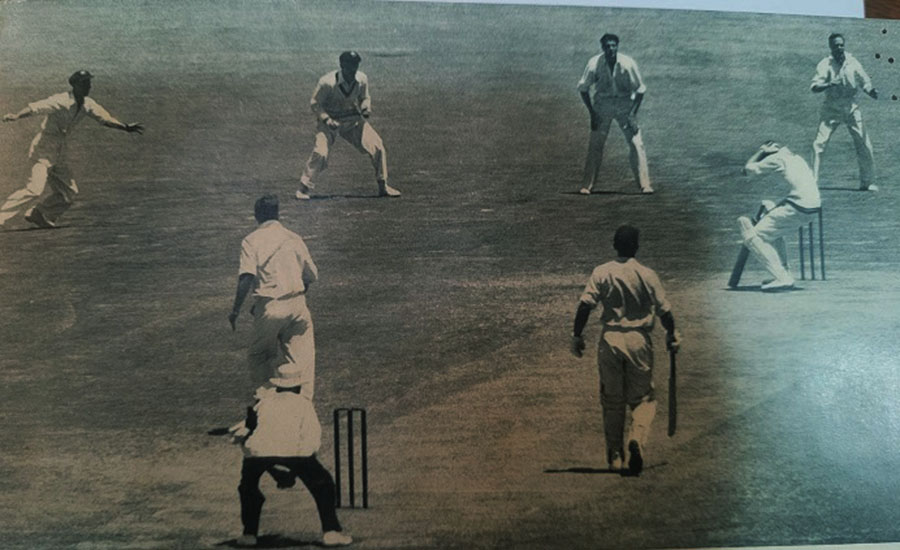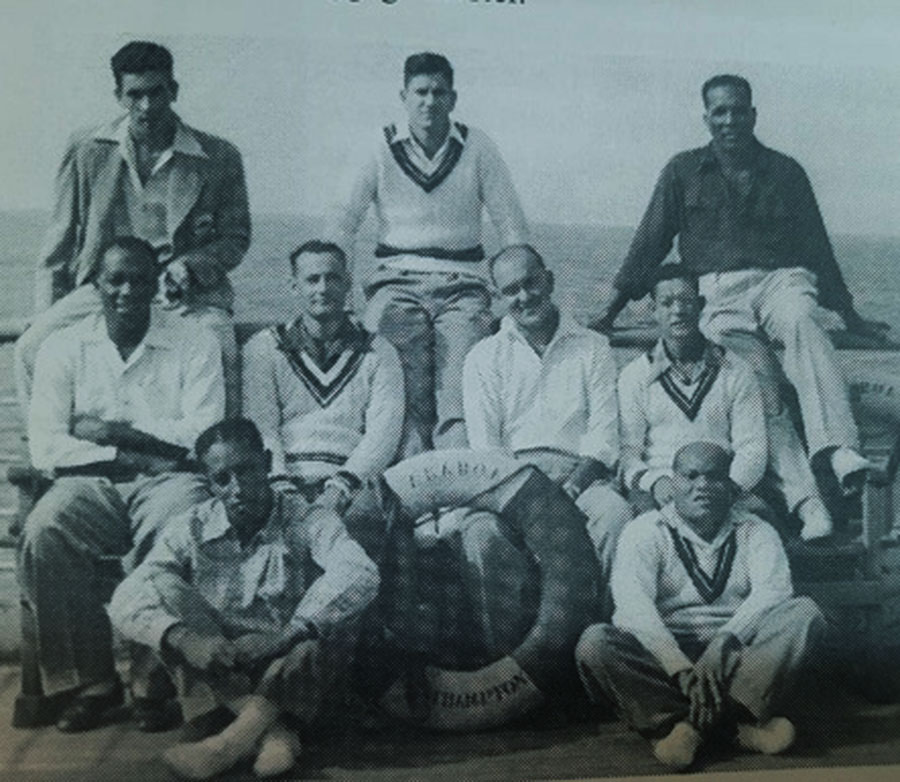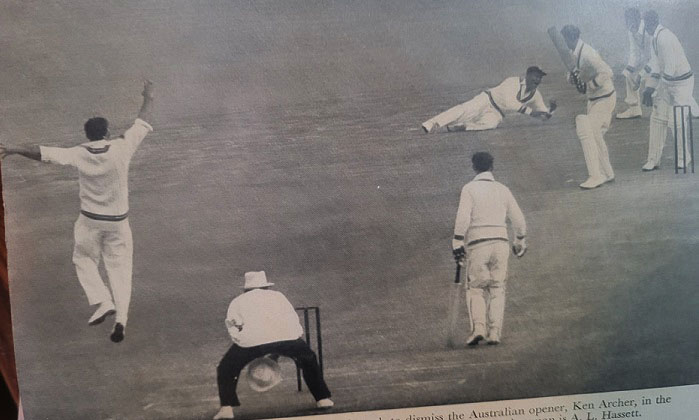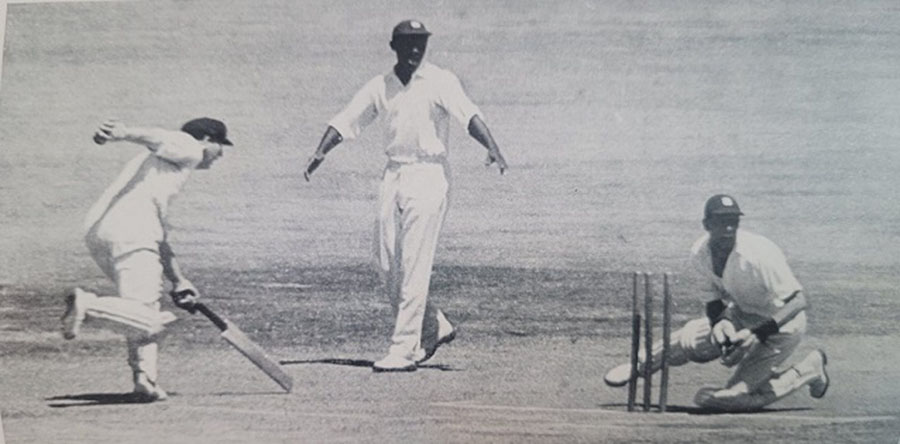The journey
On 25th October, 1950, the West Indies Cricket Board of Control (WICBC) accepted an invitation from the Australian Cricket Board (ACB) for the West Indies to visit Australia during the next season. The offer arrived hard on the heels of the team’s departure from England on 23rd September, following their 3 – 1 conquest. The team for the 1951/52 Tour of Australia and New Zealand was selected after the Quadrangular Tournament in mid-March and announced on 27th April, after the WICBC’s proposal for fees and expenses had been accepted by the professional players engaged in League Cricket in England.
The tour party departed for Australia in three separate groups. The first batch comprising Barbadians Captain John Goddard and Denis Atkinson; Trinidadians Cyril Merry (Manager), Sam Guillen, Prior Jones, and Wilf Ferguson; British Guiana players Robert Christiani and John Trim, left Trinidad on 30th August, aboard the ‘S S Akaora’. On 8th September, the ship arrived in Colon at the end of the Panama Canal, where they were joined by Alf Valentine, who had flown from Jamaica. On 24th September, ‘Akaora’ docked in New Zealand. Three days later, the team boarded the ‘S S Wanganella’, traversed the Tasman Sea, arriving in Sydney on 1st October.
The Lancashire League professionals – Barbadians Roy Marshall, Clyde Walcott, Everton Weekes, and Frank Worrell; Jamaican Ken Rickards, and Trinidadian Sonny Ramadhin – departed from Tilbury Docks in London on ‘S S Strathmore’, on 11th September, arriving in Fremantle, Western Australia, on 9th October. The cricketers, minus Marshall (who had tonsillitis and joined the team five days later), flew to Sydney the following day.
The stragglers, Trinidadians Jeffrey Stollmeyer and Gerry Gomez, and Jamaican Allan Rae, who took his Bar finals in London the last week of September, travelled via aircraft. Stollmeyer and Gomez flew to San Francisco on 5th October, where they were joined by Rae. They arrived in Sydney on 10th October, via Honolulu and Fiji.
High expectations, poor planning
According to the 1953 Wisden Cricketers’ Almanack summary of the series: “So much advance speculation described the visit of West Indies to Australia in 1951-52 as a tour designed to decide the unofficial ‘cricket championship of the world’ …”. The expectations had been built around the fact that both teams were undefeated since the Second World War. The West Indies had beaten England twice, home and abroad, and India away. The rampaging Australians had swept all and sundry in their path. In 26 Tests over six series, they won 19 times, lost once and retained the Ashes in three series, defeating New Zealand, India and South Africa in the others.
However, the tour itinerary the WICBC had consented to – which Captain Goddard was very critical of, much later – was far from ideal for a contest of such billing. Weather permitting, the vanguard had practised before the arrival of their teammates well aware of the poor schedule. The tour commenced with a suggestion from the WICBC, the staging of a testimonial match for William “Fergie” Ferguson, the West Indies scorer and baggage man. Fergie had scored for Australia, England, West Indies, South Africa and New Zealand since 1905, and was well known and loved. (Fergie, who is attributed with several innovations to recording the game, worked 208 Test matches over 43 tours.) The two teams were a West Indies XI (actually the Second Test XI) and a Combined XI comprising the rest of the West Indies players and a few Australians.
Ferguson Testimonial, 20 October, North Sydney Oval. Scores: West Indies, 251 for 5 declared; F Worrell, 130*. Combined XI, 120; R Marshall, 56*, W Ferguson, 6, S Ramadhin, 6 for 28. West Indies won by 131 runs.
Prime Minister’s XI, 22 October, Canberra. Prime Minister’s XI, 229; M Donnelly, 72, W Ferguson, 7 for 94. West Indies, 142 for 2. Rain. Match drawn.
New South Wales Country XI, 26, 27, October, Newcastle. NSW Country, 139; J De Courcy, 64, A Valentine 5 for 40 and 201 for 9 declared, A Valentine, 5 for 73. West Indies, 166; J Goddard, 53, J Bull, 6 for 60, and 176 for 2, A Rae, 54. West Indies won by 8 wickets.
Queensland Country XI, 30, 31, October, Townsville. West Indies, 460 for 5 declared; K Rickards, 192, F Worrell, 98, R Christiani, 73*, R Marshall, 51. Queensland Country, 128; D Watt, 51, A Valentine 5 for 27, and 127 for 8. Match drawn.
Four non-first-class fixtures is not the way to begin a five-Test tour labelled the “cricket championship of the world.” The West Indies made a few tough decisions heading into the only first-class fixture before the First Test. The tour selection committee opted to rest spin twins Valentine and Ramadhin, favoured a strong batting lineup, and chose only two bowlers of repute, Ferguson and Jones. The lack of proper match practice showed as the West Indians slumped to an embarrassing loss, narrowly avoiding an innings defeat following rash shot selection. It was an ominous sign.
West Indies versus Queensland, 3, 5, 6, 7, November, Brisbane. Scores: West Indies, 198; C McCool, 6 for 83, and 282; G Gomez, 97*, R Christiani, 50, V Raymer, 6 for 69. Queensland, 455; A Carrigan, 169, C Harvey, 90, K Mackay, 79, and 29 without loss. Queensland won by ten wickets.
First Test, 9, 10, 12, 13, November, Brisbane. Scores: West Indies, 216 and 245; E Weekes, 70, G Gomez, 55, D Ring, 6 for 80. Australia, 226; R Lindwall, 61, A Valentine, 5 for 99, and 236 for 7, S Ramadhin, 5 for 90. Australia won by three wickets.
The West Indies were undone by frailties against Lindwall’s barrage of bumpers, weak fielding and poor tactics. The Australians, perplexed by the spin of Ramadhin and Valentine, were let off the hook as the hapless West Indians floored five chances off Valentine in under half an hour in the first innings. With Australia on the ropes at 149 for five in their second innings, Goddard’s poor tactics were exposed; he continued in vain to the bitter end with Ramadhin and Valentine. According to Worrell, “Goddard had received ‘practically all the kudos’ for the historic triumph in the 1950 series in England, which apparently annoyed the many players who had made a bevy of good suggestions during the tour.” With the support he had taken for granted now withheld, Goddard appeared lost. Stollmeyer later described his field placings as “inexplicable”and lamented that Goddard paid little attention to the strengths and weaknesses of batsmen.
West Indies versus New South Wales, 16, 17, 19, 20, November, Sydney. Scores: NSW, 239; R Flockton, 85, and 274 for 3 declared, J Moroney, 166*. West Indies, 134, and 355; R Marshall, 114, F Worrell, 65, K Rickards, 59, C Walcott, 54. NSW won by 24 runs. At 299 for 4, the West Indies appeared to have the upper hand, only to collapse once again.
West Indies versus Victoria, 23, 25, 26, 27, November, Melbourne. Scores: West Indies, 230; C Walcott, 75, R Christiani, 70, and 181 for 2; J Stollmeyer, 94, A Rae, 62. Victoria, 195. Match drawn. Rain on the last day denied the visitors any chance of victory over the Sheffield Shield champions.
Second Test, 30, November, 1, 3, 4, 5, December, at Sydney. Scores: West Indies, 362; R Christiani, 76, F Worrell, 64, C Walcott, 60, G Gomez, 54, and 290, E Weekes, 56, J Goddard, 57*. Australia, 517; L Hassett, 132, K Miller, 129, D Ring, 65, and 137 for 3. Australia won by seven wickets. Vital chances spilled in Australia’s first inning probably cost the West Indies a glorious opportunity to level the series.
West Indies versus South Australia, 7, 8, 10, 11, December, Adelaide. South Australia, 398; B Bowley, 169, A Valentine, 5 for 112, and 155, L Duldig, 66, A Valentine, 7 for 52. West Indies, 233; C Walcott, 84, G Noblet, 5 for 50, and 93. South Australia won by 227 runs. Woeful in the field, the West Indies collapsed on a worn pitch which aided spin bowlers.
West Indies versus Western Australia, 14, 15, 17, 18, December, Perth. West Indies, 151; C Puckett, 5 for 45, and 203; C Walcott, 50. Western Australia, 108; J Trim, 7 for 80, and 247 for 9; D Williams, 51. Western Australia won by one wicket, as the last pair added 48, to inflict the sixth defeat in seven first class matches on the visitors, who lost back to back matches to two of the weakest Sheffield Shield sides.
Silver lining
Here’s an excerpt from ‘Straight Hit’ by Keith Miller and R S Whitington (1952), “The ordinary follower of cricket in Australia and in the Caribbean would look upon this defeat [at Perth] as the bottom step in the degeneration of a once fine team. But there was an Australian who had watched the West Indians’ desperate struggle to avoid defeat through the windows of the members’ stand bar. He had watched the West Indians fall to pieces in some of their earlier matches. This time he watched them fight. Half a dozen glasses of Western Australian draught beer had given him confidence. He walked to the West Indies’ dressing-room door, knocked twice and was invited in.
‘Could I say a few words to your team?’ he asked the exhausted Goddard.
‘Say what you want to,’ was Goddard’s answer.
‘A lot of people are thinking you are licked, that you might as well take the next boat home,’ the Australian began. ‘But I regard your display today as the first step in your regeneration,’ he continued. Two or three of the West Indians began to take note of what the fellow was saying. ‘I saw you lose the first two Tests against Australia. If you had fought as hard together in them as you fought together today you would now be two matches up instead of two matches down in the rubber. What’s more, if you fight as hard next weekend in Adelaide, you ‘ll win the Third Test.’ And the intruder walked out of the dressing-room.”
While the West Indies pondered the words of the intruder on the 1,500 miles overnight flight back to Adelaide, Walcott was experiencing great discomfort with his back. An x-ray revealed that he had a displaced disc and would be unavailable for the pivotal Third Test. The key middle-order batsman and wicket keeper joined the casualty list of Ferguson, Marshall, Rickards, Stollmeyer and Weekes, who were all suffering from badly strained leg muscles, and Goddard, battling tonsillitis. The West Indies were reduced to ten fit players.
On the Aussie side, Sid Barnes, who was attempting a comeback to Test cricket, was apparently selected for the Third Test. However, the selectors were overruled by a majority vote of the ACB – seven of 13 – several of whose members did not wish to see the controversial Barnes in the Baggy Green again. Jim Burke was then included in a side which had four new-ball bowlers and two spin bowlers. Skipper Lindsay Hassett woke up with back pain, the result of a crossed hip tendon. After further internal haggling between the selectors and the South Australian ACB representatives, no replacement was named. Hassett, a lame duck, stayed as the twelfth man.
On the eve of the Third Test, the West Indies held an intense two-hour batting, bowling, and fielding practice session as they sought to find the overseas form which they had displayed in India in 1948/49, where they scored over 600 in their only innings in the first two Tests, and 582 in the Fourth Test, and the 1950 series, where they enjoyed scores of 325 and 425/6, 558 and 103*, and 503, in their three victories.
Third Test, 22, 24, 25, December, Adelaide
The West Indies made three changes to the Second Test XI; Guillen earned his Maroon cap replacing Walcott behind the stumps, Marshall replaced the out-of-form Rae, and all-rounder Atkinson came for Jones
On the eve of the Test, it had rained heavily, and as had happened in Melbourne and Sydney, the wicket-covers had been penetrated. In light drizzle, Arthur Morris, who was leading Australia, won the toss and decided to bat. Within two hours, the series was alive again, as the hosts had crumbled on the damp pitch to 82 all out in the 26th over, never recovering from 43 for 5 at lunch. Worrell, bowling unchanged throughout the innings, was the wrecker, with returns of 6 for 38 from 12.7 overs. Bowling from the Northern or Cathedral End, Worrell exploited a soft spot outside the off stump at the Southern, or River End. Gomez delivered three overs before Goddard replaced him, taking three for 36 from eight overs. At the Northern End, the ball kicked and came off the pitch at varying paces
The upbeat West Indians, possibly benefiting from the use of the roller between innings taking the sting out of the pitch, got a solid start with Stollmeyer and Marshall, who added 25 off five overs. Then it was Bill Johnston’s turn to emulate Worrell, wreaking havoc, with his medium-pace leg spinners, as he reduced the visitors to 51 for five in less than an hour. Goddard, figuring that the match was going to be decided on second innings scores, consulted the rule book, and found that Law 15 stated, “The captain of the batting side may declare an innings closed in a match of three days or more at any time on the second and succeeding days.” With declaring not an option, the skipper then issued specific instructions to go for runs or get out, as Johnston captured six for 62 off 12 overs, restricting the West Indies to 102, a lead of 23. Weekes’ 26, made while limping from a pulled muscle, was the top score.
Australia adopted the tactic employed by Captains Jackie Grant and Bob Wyatt in the First Test of the 1935 series between West Indies and England at Kensington Oval, Barbados, of reversing the batting order in the second innings on the rain affected pitch. With 25 minutes remaining, first innings’ numbers seven and nine, Ian Johnson and Gil Langley, respectively, opened the batting. The day’s drama was not over, as Valentine delivered two maiden overs and captured the wickets of Johnson and hometown boy, Geff Noblet, who batted tenth in the first inning. Australia, 20 for two. Twenty-two wickets had fallen on the first day for 207 runs in 271 minutes, 14 of which had been snared by the left-handers, Worrell, Johnston and Valentine.
When the match resumed on Christmas Eve after the rest day, the pitch had lost its sting and the bonafide tailenders, Langley and Doug Ring swotted boundaries off the famed spin duo. Langley was eventually bowled by Valentine, for 23, in 82 minutes, whilst Ring plundered his way to 65 not out at lunch, having struck two massive sixes and eight fours. At 145 for three at the break, the momentum was shifting Australia’s way. Not for long. Three wickets fell in 34 minutes, as the Australians slumped to 172 for six, as the match swung again. Despite the efforts of Miller, 35, Hole, 25, and Burke, 15, the hosts could only manage 255, a lead of 232, as Valentine’s magical spin returned six for 102.
Stollmeyer, 33*, and a limping Marshall (Rae as a runner), 18*, began the chase late in the afternoon and saw the West Indies safely to stumps at 54 without loss.
Christmas Day
Stollmeyer and Marshall took the score to 72, when the latter was caught behind, trying to cut Ring. The former followed soon after, 85 for two. The openers had laid a solid foundation, now it was up to the others to chip in. Worrell, who was in torrid form, and Weekes, consolidated the innings, as the West Indians coasted to lunch, at 139 for two – 94 needed, eight wickets in hand., victory in sight.
The momentum swung swiftly once again after lunch, as both Ws were caught off defensive strokes. 141 for four. Two new batsmen at the crease, Christiani and Gomez. The crowd grew quiet as the tension mounted and nerves frayed. Lindwall dropped a sitter off Gomez. Christiani advanced down the pitch, sometimes driving, patting the ball on other occasions. It was early morning back in the Caribbean; listeners were glued to their shortwave radios. Christiani and Gomez lived charmed lives, surviving appeals for stumpings and LBWs. Christiani wiped his glasses several times. Gomez adjusted his pad and wiped his brow. They dug in, refusing to wilt as the battle raged.
The score entered the 180s, as Morris claimed the new ball. Lindwall thundered in, a short ball, high and fast, knocking the bat out of Gomez’s hands. The ball ballooned to Ring at point, who ambled over, got both hands to it, and then dropped it. Last chance! Growing in confidence, sensing the tide swinging in their favour, the pair took boundaries off Lindwall and Johnston. Ring returned, and Christiani swung him to the long-leg fence. Finally, at ten to four, Christiani drove Ring to long-on for two for the winning runs. Gomez, 46* and Christiani, 42*, had added 92 , guiding the West Indies to an improbable victory, delivering an unexpected Christmas gift to the fans back home. Two weeks before, on the same ground, they had been dismissed for 93.
In celebrations that night at the Glenelg’s Pier Hotel, where the West Indians were billeted, Jones was on the piano, Guillen, Eytle, Stollmeyer and Gomez led the calypso singing, as they enjoyed the only Christmas Day Test victory.
Postscript
The ACB had scheduled play on Christmas Day in the hope that the holiday would attract a greater attendance, much to the consternation of the Australian players who would have preferred to spend the day at home with their families. Less than 3,000 spectators showed up for the last day, the rest of the fans concluding that the result was a foregone conclusion. Hard-core fans had listened to the commentary on radio, savouring the excellent match description provided by Australians Vic Richardson, Johnnie Moyes, Alan McGilvray, and Guyanese Ernest Eytle (who was based in England and worked for the BBC), known in Australia as the “Golden-voiced colt”.
In 1967, Australia and India played on Christmas Day during the First Test, also at Adelaide, with Australia winning by 146 runs on 28 December.
The West Indies narrowly lost the Fourth Test by one wicket, as Ring and Bill Johnston added 38 for the last wicket. Australia won the Fifth Test by 202 runs. As the 1953 Wisden Cricketers’ Alamanck duly noted, “Notwithstanding the batting disappointments, the West Indies might easily have won the rubber three to two.”
